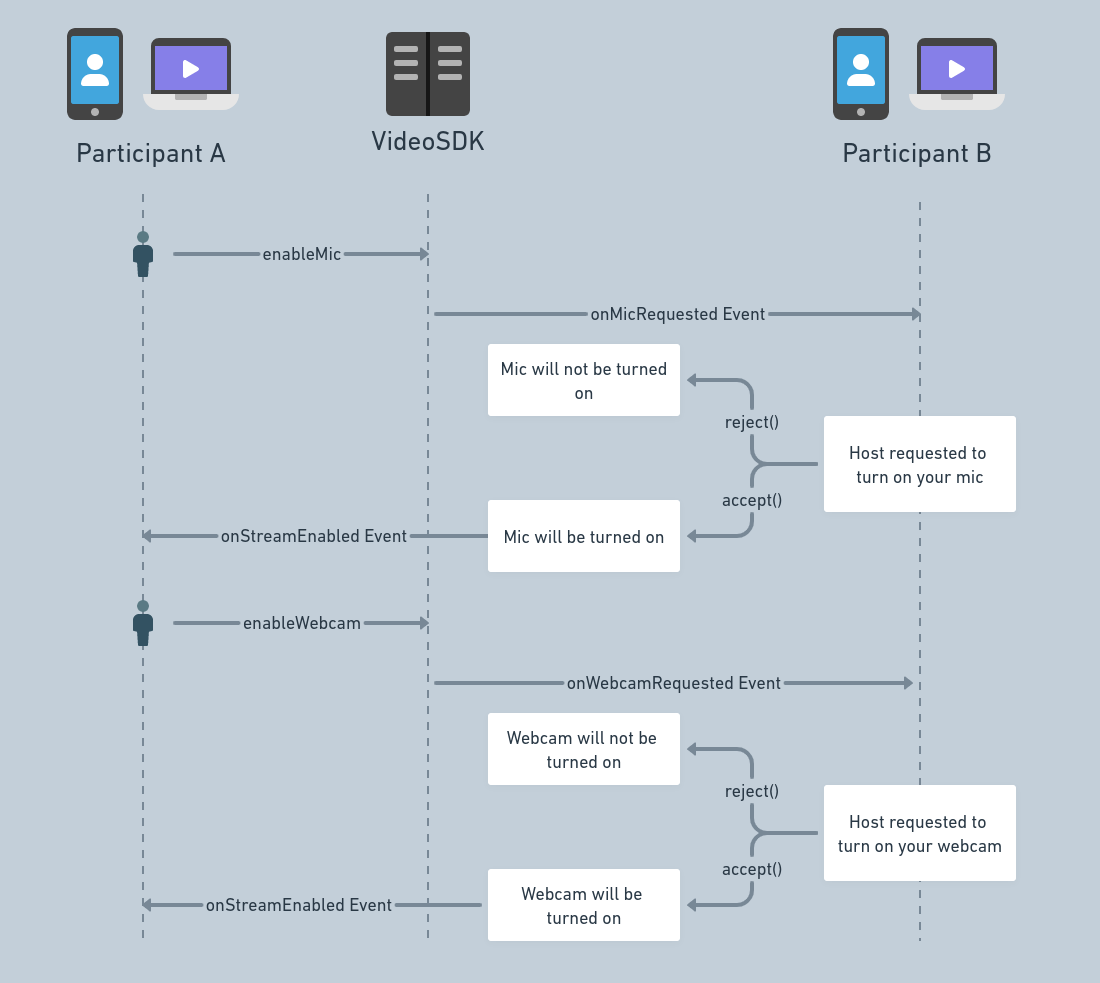Toggle Remote Participant Media - Flutter
When hosting a meeting, it's important that the host of the meeting should be able to request someone's Mic or Camera to be turned on or should be able to turn them off.
Participant who will be controlling other participant's mic and camera should have permission allow_mod passed in the token. To know more about permissions visit here.
Before we discuss the methods and events associated with this functionality, here is how the flow would look like.

Methods
unmuteMic()
-
If you wish to turn on the microphone of a participant, you will be calling the
unmuteMic()on theParticipantobject. -
When this method is called, the participant whose microphone is requested will receive the
Events.micRequestedevent with theparticipantIdof the participant who requested it and two callback functionsacceptandrejectwhich should be called based on decision made by the user. -
Example: Meeting is running with Participant A and Participant B. Now Participant A wants to unmute Mic of Participant B, so Participant A will use
unmuteMic()function to request Participant B, after that Participant B recieve theEvents.micRequestedevent, from there user can either accept or reject the incoming request.
enableCam()
-
If you wish to turn on the camera of a participant, you will be calling the
enableCam()from theuseParticipanthook. -
When this method is called, the participant whose camera is requested will receive the
Events.cameraRequestedevent with theparticipantIdof the participant who requested it and two callback functionsacceptandrejectwhich should be called based on decision made by the user. -
Example: Meeting is running with Participant A and Participant B. Now Participant A wants to Enable Cam of Participant B, so Participant A will use
enableCam()function to request Participant B, after that Participant B recieve theEvents.cameraRequestedevent, from there user can either accept or reject the incoming request.
muteMic()
- If you wish to turn off the microphone of a participant, you will be calling the
muteMic()on theParticipantobject. - This will disable the microphone of the participant.
disableCam()
- If you wish to turn off the camera of a participant, you will be calling the
disableCam()on theParticipantobject. - This will disable the camera of the participant.
Example
import 'package:flutter/material.dart';
import 'package:videosdk/videosdk.dart';
class ParticipantTile extends StatefulWidget {
final Participant participant;
const ParticipantTile({super.key, required this.participant});
@override
State<ParticipantTile> createState() => _ParticipantTileState();
}
class _ParticipantTileState extends State<ParticipantTile> {
@override
Widget build(BuildContext context) {
return Column(
children: [
ElevatedButton(
child: Text("Enable Mic"),
onPressed: () => {
widget.participant.unmuteMic();
}),
ElevatedButton(
child: Text("Disable Mic"),
onPressed: () => {
widget.participant.muteMic();
}),
ElevatedButton(
child: Text("Enable Cam"),
onPressed: () => {
widget.participant.enableCam();
}),
ElevatedButton(
child: Text("Disable Cam"),
onPressed: () => {
widget.participant.disableCam();
}),
],
);
}
}
Events
camemaRequested
This event will be emitted to the Participant B when any other Participant A requests to enable webcam of that participant (Participant B). This event handler will receieve following three arguments in the Map<String, dynamic>:
accept()- Callback function to accept the request.reject()- Callback function to reject the request.participantId- ParticipantId of the requesting participant
micRequested
This event will be emitted to the Participant B when any other Participant A requests to enable mic of that participant (Participant B). This event handler will receieve following three arguments in the Map<String, dynamic>:
accept()- Callback function to accept the request.reject()- Callback function to reject the request.participantId- ParticipantId of the requesting participant
Usage
import 'package:flutter/material.dart';
import 'package:videosdk/videosdk.dart';
class MeetingScreen extends StatefulWidget {
...
}
class _MeetingScreenState extends State<MeetingScreen> {
late Room room;
@override
void initState() {
...
setupRoomEventListener();
}
@override
Widget build(BuildContext context) {
return YourMeetingWidget();
}
void setupRoomEventListener() {
//Event for mic request
room.on(Events.micRequested, (_data_) {
log("_data => $_data");
dynamic accept = _data['accept'];
dynamic reject = _data['reject'];
log("accept => $accept reject => $reject");
// Mic Request Dialog
showDialog(
context: navigatorKey.currentContext!,
builder: (context) => AlertDialog(
title: const Text("Mic requested?"),
content: const Text("Do you want to turn on your mic? "),
actions: [
TextButton(
onPressed: () {
reject();
Navigator.of(context).pop();
},
child: const Text("Reject"),
),
TextButton(
onPressed: () {
accept();
Navigator.of(context).pop();
},
child: const Text("Accept"),
),
],
),
);
});
// Called when camera is requested
room.on(Events.cameraRequested, (_data) {
log("_data => $_data");
dynamic accept = _data['accept'];
dynamic reject = _data['reject'];
log("accept => $accept reject => $reject");
// camera Request Dialog
showDialog(
context: navigatorKey.currentContext!,
builder: (context) => AlertDialog(
title: const Text("Camera requested?"),
content: const Text("Do you want to turn on your Camera? "),
actions: [
TextButton(
onPressed: () {
reject();
Navigator.of(context).pop();
},
child: const Text("Reject"),
),
TextButton(
onPressed: () {
accept();
Navigator.of(context).pop();
},
child: const Text("Accept"),
),
],
),
);
});
}
}
API Reference
The API references for all the methods and events utilised in this guide are provided below.
Got a Question? Ask us on discord

